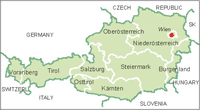
Settlments
 Salzburg is the fourth-largest city in Austria and the capital of the federal state of Salzburg. Salzburg's "Old Town" (Altstadt) with its world famous baroque architecture is one of the best-preserved city centres north of the Alps, and was listed as a UNESCO World Heritage Site in 1997. The city is noted for its Alpine setting. It is the birthplace of Wolfgang Amadeus Mozart and the setting for parts of the musical and film The Sound of Music, which features famous landmarks in Austria, but focuses mainly on Salzburg. Salzburg is a student city, with three universities.
Salzburg is the fourth-largest city in Austria and the capital of the federal state of Salzburg. Salzburg's "Old Town" (Altstadt) with its world famous baroque architecture is one of the best-preserved city centres north of the Alps, and was listed as a UNESCO World Heritage Site in 1997. The city is noted for its Alpine setting. It is the birthplace of Wolfgang Amadeus Mozart and the setting for parts of the musical and film The Sound of Music, which features famous landmarks in Austria, but focuses mainly on Salzburg. Salzburg is a student city, with three universities.
Three Prince Archbishops in particular, Wolf Dietrich von Raitenau, Markus Sittkus and Paris Lodron transformed the Medieval city into a gem of Baroque architecture. You will not find a similar place anywhere in Europe: Marvel at the elaborate cathedral (Salzburger Dom), the castle Hohensalzburg (supposedly the biggest in Central Europe), and the scenic hills on the northern edge of the Alps.
Dozens of baroque churches and Europe′s oldest nunnery that was in constant use (Stift Nonnberg), other monasteries like the Capuchin one or the ancient Benedictine Abbey St. Peter, the Mirabell Palace and its beautiful gardens, and more than a dozen more palaces and castles just in the city itself would do enough to keep the tourism going.
 Bad Gastein became one of Europe′s most exclusive spa towns in the late 19th century and is still full of fin de siecle hotels - many of them are now empty. With the construction of a railway through the Gasteinertal in 1909, Bad Gastein was finally opened to modern mass tourism - but still of a very exclusive kind. Bad Gastein is also where most hot springs originate. The water of these springs is rich in the radioactive gas Radon - a fact that was determined by double-Nobel laureate Marie Curie.
Bad Gastein became one of Europe′s most exclusive spa towns in the late 19th century and is still full of fin de siecle hotels - many of them are now empty. With the construction of a railway through the Gasteinertal in 1909, Bad Gastein was finally opened to modern mass tourism - but still of a very exclusive kind. Bad Gastein is also where most hot springs originate. The water of these springs is rich in the radioactive gas Radon - a fact that was determined by double-Nobel laureate Marie Curie.
Once the Roman Empire had fallen, Bavarian tribes populated the Gasteinertal and in 1218, it became part of the Duchy of Bavaria. In 1297, Bavaria sold it to the Archdiocese of Salzburg, where it remained until today - after the secularisation of Salzburg in the 19th century as part of the Austrian federal province.
There are indications in a poem from 1230 that the springs of Bad Gastein were already used by then - there is definite evidence for organised bath action after 1350. Soon, something like a late Medieval and Renaissance spa culture developed, with celebrity visitors such as Emperor Friedrich III or the doctor and alchemist Paracelsus in the 15th and 16th century respectively.
 Radstadt - a place of lots of possibilities! Skiers find 860 km of best prepared pists within 270 skilifts in the region Ski Amade and Radstadts position in the middle is a good argument for a stay in the mediavel small town with its 5000 inhabitants.
Radstadt - a place of lots of possibilities! Skiers find 860 km of best prepared pists within 270 skilifts in the region Ski Amade and Radstadts position in the middle is a good argument for a stay in the mediavel small town with its 5000 inhabitants.
The town of Radstadt, the main hub of the SalzburgerLand's Ennspongau region, lies at 856 metres above sea level on a terrace which falls off on three sides. With Bavarian settlement in the 7th century and the subsequent Christianization of the area, we find the actual beginnings of Radstadt's history. On July 27, 1289, Archbishop von Hohenegg issued a proclamation conferring upon the citizens of Radstadt ("Cives in Rastatt") those same town rights, privileges and liberties which were also enjoyed by the city of Salzburg and other towns within the archbishopric, also exempting Radstadt's citizenry from all taxes and duties for a period of ten years, with the exception of those expenses which were necessary for the fortification and defense of the town. This same document also contains the civic rights of Radstadt itself and was the occasion for anniversary celebrations in 1989.
 Back to top
Back to top


 Romana
Romana English
English











